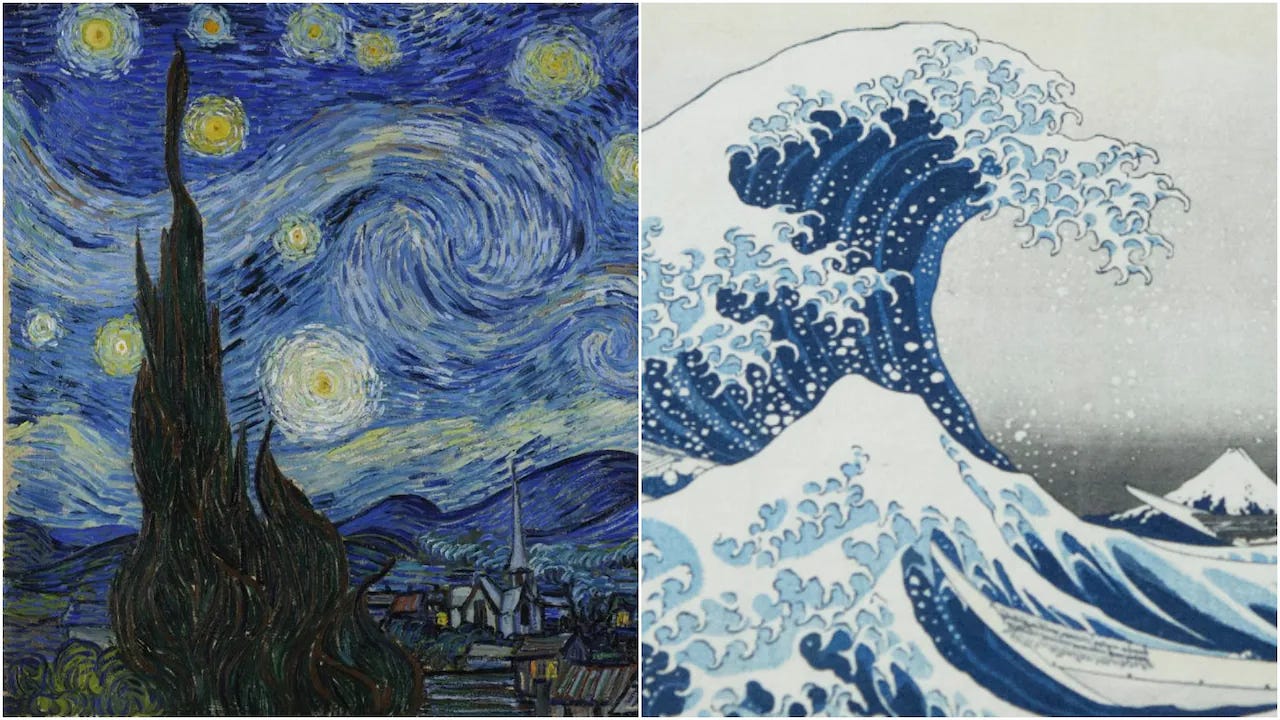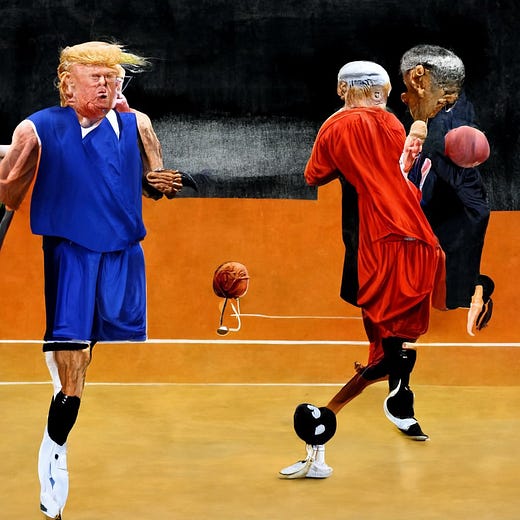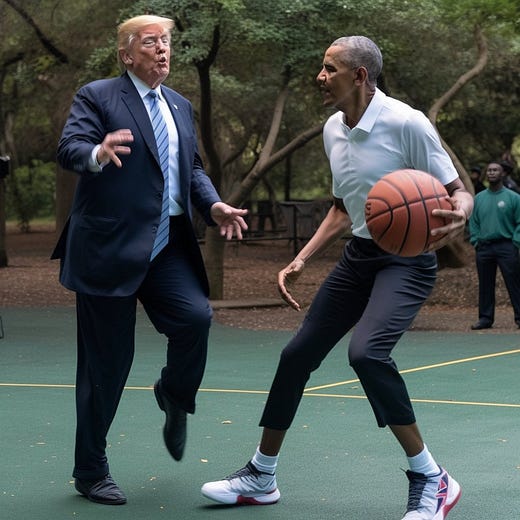The Camera, Van Gogh and "The Starry Night"
How the invention of the camera changed art and led to Van Gogh's classic painting.
Thanks for subscribing to SatPost.
Today, we’re talking about Vincent Van Gogh’s “The Starry Night” painting (and why it matters in our current Age of AI).
Also this week:
The end of TikTok?
Which jobs are most exposed to AI?
And some wild tweets (including an amazing Succession parody)
“The Starry Night” is a great lesson on how technology changes art and creative work.
Vincent Van Gogh created his masterpiece in 1889. But the painting style was born from the art world's response to the invention of the camera decades earlier.
To trace a connection between the camera and “The Starry Night”, we start with Van Gogh’s early years: the Dutch painter was born in 1853 in Zundert, Netherlands and had a fascination with art from a young age. His interest included a short stint as an art dealer. But through his teens and 20s, poor mental health hampered Van Gogh’s ability to focus and kept him from holding a job. In 1881 — at the age of 28 — he moved back in with his parents (I actually did the same while getting my MBA but have yet to paint any masterpieces).
With financial and emotional support from his younger brother Theo, Van Gogh began to paint more seriously. The two brothers frequently exchanged letters, providing future generations with an insight into Van Gogh's psyche.
Van Gogh's early works were character and setting studies. Compared to his more famous art, there was a lack of color in the pieces. But this drab style was very much in line with the post-Enlightenment norm of painting scenes as a form of documentation (aka make it look as real as possible).
Now, let's rewind back to 1839. That year saw the development of the first photographic camera for commercial use: the Daguerre camera, named after French artist Louis Daguerre (who invented a new type of photochemistry). While the Daguerre camera required 30 minutes of light exposure to produce a photograph, that was a much shorter amount of time than the hours required of photography devices from the early decades of the 1800s.
Below is the Daguerre camera and what is believed to be the first Daguerreotype photograph of a human face, taken in 1839 (the subject is Dorothy Draper and the photographer is her brother John).
Camera technology advanced quickly and the ability to capture real-life images no longer required an artist. Up to this point, the norm for having “a portrait done" was to commission a painter. Portrait painting of everyday people was not glamorous. It was a workmanlike trade and comparable to a profession like carpentry. The highest esteem for artists was to paint historical settings and figures.
By 1849, more than 100,000 Parisians had a portrait taken by camera per the Kiama Art Blog. This meant that there was a ready substitute for one of the most utilitarian art jobs. On the one hand, artists that didn’t take up photography lost a source of income. On the other hand, many artists were freed to try new painting techniques.
But it wasn’t until the 1870s that the art world truly changed in response to the invention of the camera. An art professor on the subreddit r/AskHistorians provides a detailed breakdown, specifically focusing on the rise of Impressionism:
[By the 1870s and 1880s] they are a generation of artists who have lived with photography essentially their whole lives. Furthermore, photography was one of many new 19th century technologies that prompted advances in the science of optics, and the Impressionists were by and large immersed in this new world.
Rather than try to compete with photography for claims to objective truth, they were in essence freed by it. Aware of advances in the understanding of color, for example, they knew that by placing areas of pure color next to one another, they could produce a blended effect in the mind, which is how they developed their distinctive facture (facture is the art historical term for an artist’s unique handling of the paint).
In essence, they doubled down on the subjective nature of art, the way in which it represents not some universal perception but rather an individual one. They translated their own experience of the world at any given date and time into paint. And in the process they changed art forever. By decoupling painting and objective vision once and for all, they inaugurated what we art historians know as high modernism, of all those avant-garde isms you may be familiar with, from Impressionism, to Fauvism, to Cubism and on to the complete abstraction of the middle of the twentieth century.
It is not too much of an exaggeration to say that photography indirectly helped develop modern and postmodern art as we known it.
Artists like Claude Monet — the preeminent Impressionist — tried techniques that were different from what a camera could capture (playing with light, color and brushstrokes). Monet’s most famous works were reality filtered through his subjective lens.
Back to Van Gogh: he followed his brother Theo to Paris in 1886 (then Arles, France in 1888). In France, Van Gogh was exposed to Monet and other Impressionists. The budding artist transitioned from his earlier dark Dutch painting style to a brighter palette and created art that translated the world through his personal lens. Unfortunately, he suffered another mental breakdown and mutilated himself in the infamous “ear-cutting” incident. He spent months in a hospital before checking into a psychiatric institution in Saint-Rémy, France in May 1889.
What followed was a creative explosion for Van Gogh, as detailed by Great Art Explained. Saint-Rémy was quite a progressive asylum. As part of the healing process, the institution believed it was crucial to surround patients with nature. Van Gogh spent the next year on a strict schedule and made 150 paintings including many landscape works that were inspired by the view from his asylum bedroom.
One such painting: “The Starry Night”, which Van Gogh created on the evening of June 23rd, 1889. Van Gogh made the painting in a studio room (different than his bedroom view). It was actually done during the daytime and meant he painted it from memory (aka very subjective).
To be sure, Van Gogh drew from many inspirations outside of Impressionism. He was a fan of Japanese artist Katsushika Hokusai, who painted “The Great Wave”. And side effects from an epilepsy drug (digitalis) may have lead to a yellow tinge in Van Gogh’s vision.
Either way, it was not the first time Van Gogh painted a starry night sky. He previously did two other ones that you have probably seen:
“Cafe Terrace at Night” (September 1888)
“Starry Night Over The Rhone” (September 1888)
Notice that the night sky in these paintings are much more “realistic” than the one Van Gogh painted while at Saint-Rémy. However, Van Gogh believed that the realism was important. In a letter to French painter Emile Bernard, Van Gogh said “The Starry Night” was a failure because it was too abstract and unrealistic.
Within 14 months after the completion of “The Starry Night”, Van Gogh was dead from a self-inflicted gunshot wound. He was 37 years old and had only sold one painting during his life.
Today, “The Starry Night” is displayed at The MOMA in New York. It is the 3rd most visited painting in the world (after Mona Lisa and The Sistine Chapel). So, it turns out that Van Gogh's most subjective painting would become his most enduring work.
Astrophysicist Neil deGrasse Tyson has a beautiful explanation as to why Van Gogh’s masterpiece has so resonated:
“You know what I like about The Starry Night?
It’s not what Van Gogh saw that night, it’s what he felt.
[The painting] is not a representation of reality and anything that deviates from is reality that has filtered through your senses. And I think art at its highest is exactly that.
If this was an exact depiction of reality, it would be a photograph and I don’t need an artist.”
Over the past 6 months, I can’t stop thinking of the line, “It’s not what Van Gogh saw that night, it’s what he felt.”
Why? Because of the incredible developments in generative artificial intelligence (AI) for text and images. The invention of the camera changed how artists painted. Likewise, these AI tools will change all manner of human creative outputs.
As someone building an AI-powered research app, I believe that this wave of technology will augment our creativity as oppose to replace it. However, the text and image models are improving so fast that we can’t rule out AI completely winning the creative race. At least based on technical ability, speed and volume.
But that is why the Van Gogh story is so relevant. “The Starry Night” is a reminder of what creative work — with or without the assistance of technology — is worth being made. And worth us caring about.
In the face of ever-improving generative AI, the only thing I know for sure is that each person will be able to cultivate one competitive edge: yourself. You need to express yourself more. Your life more. Your quirks more. Your humor more. Your filter more.
Translate your own experience into creative work. Because if you are only expressing what can be “seen”, technology has it covered. But what can be “felt”? That is still uniquely ours.
Links and memes
It is link madness today people.
First is them AI links:
Can AI be creative? Yes, at least with chatbots. Researchers compared “human-generated ideas with those generated by six Generative Artificial Intelligence (GAI) chatbots…Humans and a specifically trained AI independently assessed the quality and quantity of ideas. We found no qualitative difference between AI and human-generated creativity, although there are differences in how ideas are generated.” (Arxiv)
What jobs will AI replace? OpenAI released a research report looking at what share of an occupation has exposure to GPT language models (exposure = reducing the time to do a task by at least half): financial managers (13% exposure), graphic designers (13%), PR specialists (67%), poets (69%), interpreters (77%), accountants (100%) etc.
ChatGPT plugins: OpenAI released plugins for ChatGPT with partners including Shopify, Expedia, Instacart, Zapier, OpenTable, Wolfram. McKay Wrigley compares the growing OpenAI ecosystem to how Apple dominates mobile (OpenAI is Apple. GPT-4 is the iPhone. ChatGPT is iOS. Plugins are the App Store).
Bill Gates on AI, saying “Artificial intelligence is as revolutionary as mobile phones and the Internet” and gives his predictions on its impact on health, education and inequality. (Gates Notes)
The backstory of why Elon left OpenAI: Elon donated the organization’s first $100m. In 2018, he felt OpenAI was falling behind Google in AI research and attempted to take over operations, but was rebuffed. So, Elon walked away. And Sam Altman took the reins while taking zero equity in the for-profit OpenAI business. (Semafor)
Text-to-image tool MidJourney is getting much better. Here is a Twitter thread of examples but if you’re too lazy to click, enjoy this tweet.
Second is them Van Gogh links:
The unexpected math behind "Starry Night" is an interesting Ted Ed breakdown of the physics behind the swirls in Van Gogh’s painting. (YouTube)
Don McLean wrote the song “Vincent” as a dedication to Van Gogh. Most people know it as “Starry Night”. It was one of Tupac’s favorites and apparently the last song the rapper ever heard. (Wikipedia)
British sci-fi show Dr. Who has a famous scene in which Van Gogh time travels to modern-day and sees how much the world loves his work…the 3-minute scene is tear-jerker. (YouTube)
Third is them other baller links:
Succession Season 4 begins on March 26…so enjoy this parody of Logan Roy trying to order a Domino’s Pizza. (Twitter)
The CEO of TikTok (Shou Zi Chew) testified before Congress on Thursday. In a 4-hour grilling that no amount of Red Bull could have salvaged, Chew had the impossible job of answering “yes or no” questions about TikTok’s data security and its relationship with the Chinese Communist Party (which has a board seat on TikTok’s parent firm Bytedance). The general consensus after the testimony is that Chew is definitely not in charge of TikTok. What’s next? TikTok’s Chinese founders own 20% of the company (with super voting rights), so a forced sale may only cost $10B to take out that stake with the rest owned by foreigners. However, if the CCP won’t allow a sale — which it says it will not, basically confirming its veto power on the issue — then US courts will have to decide the legality of a TikTok ban. (Axios)
…and here some wild tweets:
Finally, this fake Linkedin profile I posted has some of the funniest quote re-tweets I’ve ever read:
“Guess they’re taking another year off”
“I feel like this person is maybe not meant to work?”
“Hiring this person is the equivalent of showing your buddy a picture of a girl waiting on you back home in a war movie”
“This person is the Forrest Gump of tech scams”














The camera has certainly pushed artists to reinvent painting, but has also given rise to a new art that uses it: photography.
Vincent, Don McLean, and Tupac! Wow, what a connection. Thanks for this.